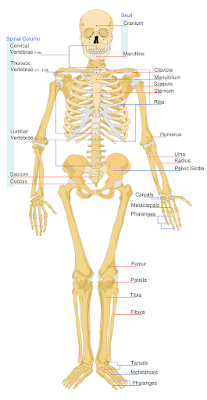10 Steps to Understanding the Skeletal System: Your Body's Bony Scaffold
Our bodies are marvels of engineering, and the skeletal system forms the very foundation upon which everything else rests. This intricate network of bones provides structure, support, and protection, allowing us to move, breathe, and interact with the world around us. But beyond its basic functions, the skeletal system holds a wealth of secrets about our health, growth, and even our evolutionary history.
In this 10-step journey, we'll delve into the fascinating world of bones, exploring their structure, function, and the intricate dance they perform with other systems in our bodies.
Step 1: Unveiling the Building Blocks - Bone Basics
Our bones may seem like solid, unchanging structures, but they are actually living tissues in a constant state of renewal. The primary component of bone is calcium phosphate, which gives it its rigidity. Embedded within this mineral framework lies a web of collagen fibbers, a protein that provides flexibility and strength. This unique composite material, known as bone matrix, makes bones remarkably strong yet somewhat elastic.
Step 2: A Shape for Every Function - Bone Diversity
Not all bones are created equal! The human skeleton boasts over 200 bones, each meticulously crafted for its specific role. Long bones, like the femur in your thigh, provide leverage for movement. Short, sturdy bones, such as the carpals in your wrist, offer stability and support for delicate joints. Flat bones, like your ribs, protect vital organs. And irregular bones, like the vertebrae in your spine, combine strength with flexibility to house your spinal cord.
Step 3: Inside the Bone - A Microscopic Marvel
A closer look reveals the intricate internal structure of bones. The outer layer, called compact bone, is dense and tightly packed, giving bones their characteristic strength. Inside, a network of spongy bone, aptly named cancellous bone, provides lightweight support with its honeycomb-like structure.
Step 4: The Joys of Joints - Movement Made Possible
Bones wouldn't be much use without the remarkable structures that connect them – joints. These ingenious junctions allow for a vast range of motion, from the gliding movement in your wrist to the hinge-like action of your knee. Different types of joints, such as ball-and-socket, hinge, and gliding joints, provide the specific movements needed for various body parts.
Step 5: Cartilage - The Unsung Hero of Joints
Cartilage plays a crucial role in joint health. This smooth, elastic tissue cushions the ends of bones at joints, ensuring smooth, friction-free movement. Additionally, cartilage acts as a shock absorber, protecting bones from wear and tear.
Step 6: The Powerhouse Partnership - Bones and Muscles
Bones and muscles work hand-in-hand to enable movement. This coordinated effort allows us to perform everything from walking and running to lifting objects and maintaining posture.
Step 7: The Symphony of Support - Ligaments and Tendons
While muscles provide the power, ligaments and tendons act as the stabilizers and messengers in the movement symphony. Strong, yet flexible ligaments connect bones to other bones, providing stability to joints. Tendons, on the other hand, connect muscles to bones, transmitting the force generated by muscle contractions to move bones.
Step 8: The Master Conductor - The Nervous System and Skeletal Control
The nervous system plays a vital role in coordinating skeletal movement. Our brains send signals through nerves to specific muscles, triggering contractions that result in movement. This intricate communication system allows us to control our movements with remarkable precision.
Step 9: A Lifelong Journey - Growth, Repair, and Maintenance
Our bones are not static structures. Throughout our lives, they undergo a continuous process of growth, remodelling, and repair. In childhood and adolescence, specialized cells in the bones, called osteoblasts, work tirelessly to build new bone tissue, enabling growth. As we age, another set of cells, osteoclasts, become more active, breaking down old bone tissue. This dynamic balance ensures that our bones remain strong and adapt to the stresses of daily life.
Step 10: Keeping Your Bones Healthy - A Lifelong Commitment
Strong, healthy bones are essential for a fulfilling life. Here are some key steps to keep your skeletal system in top shape:
Diet: Ensure adequate calcium intake through dairy products, leafy greens, and calcium-fortified foods. Vitamin D is also crucial for calcium absorption, so include sources like fatty fish or consider supplements.
Exercise: Regular weight-bearing exercises like walking, running, and strength training stimulate bone growth and improve overall bone density.
Lifestyle Choices: Limit smoking and excessive alcohol consumption,
Conclusion:
The skeletal system is a marvel of biological engineering, providing structural support, protection, and mobility to the human body. Through understanding its anatomy, functions, and role in overall health, we gain insights into the complexities of human physiology. By following these 10 steps to understanding the skeletal system, individuals can appreciate the intricacies of their own bodies and make informed choices to maintain skeletal health throughout life.






.jpg)

0 Comments